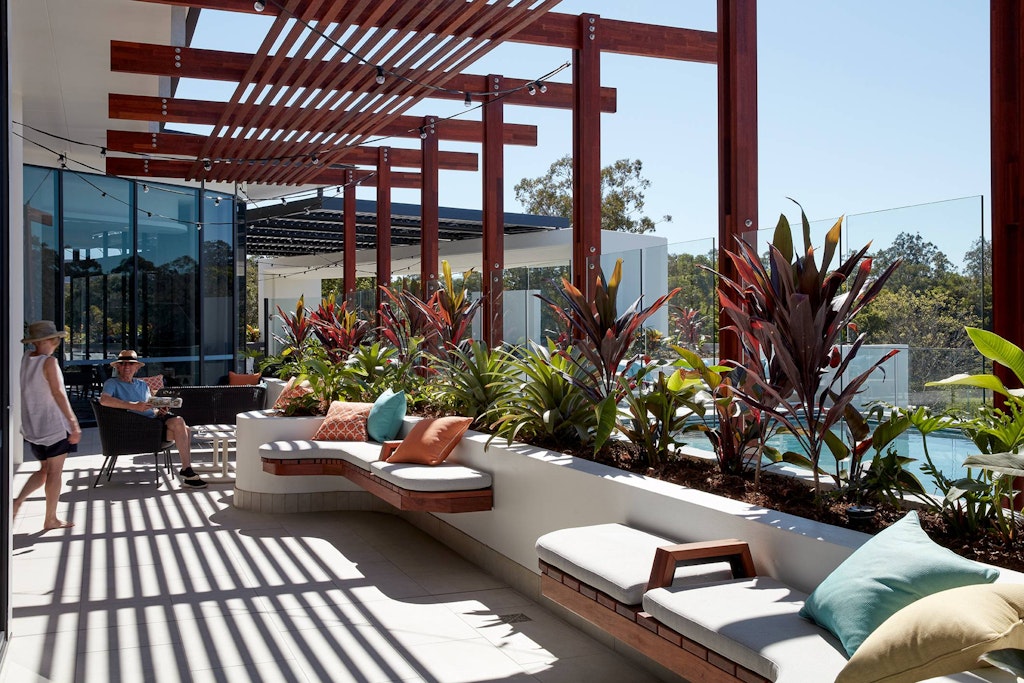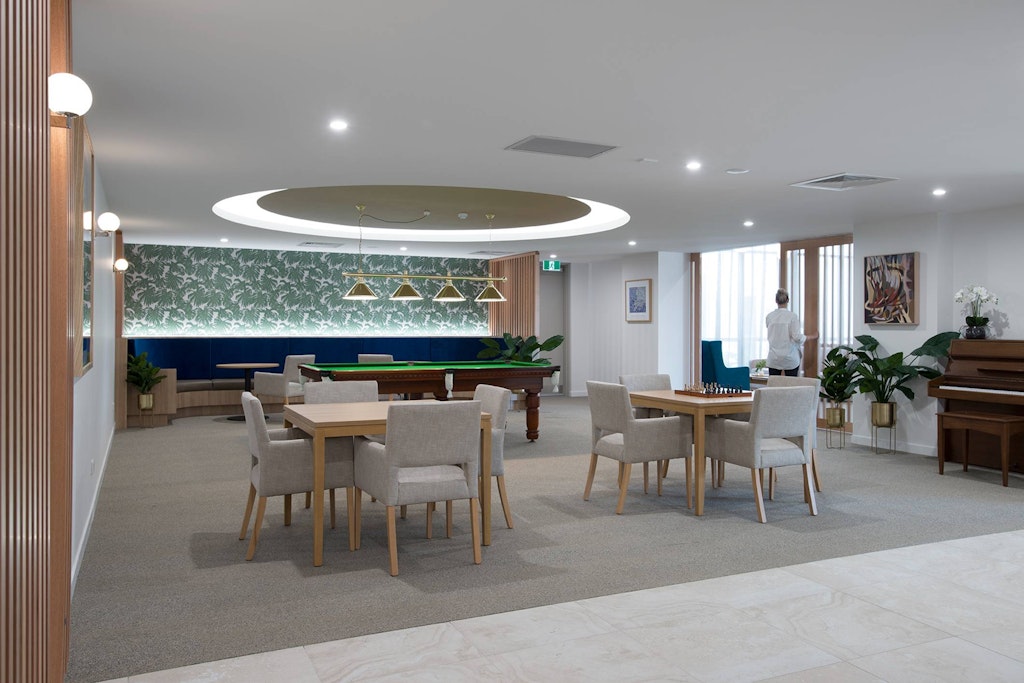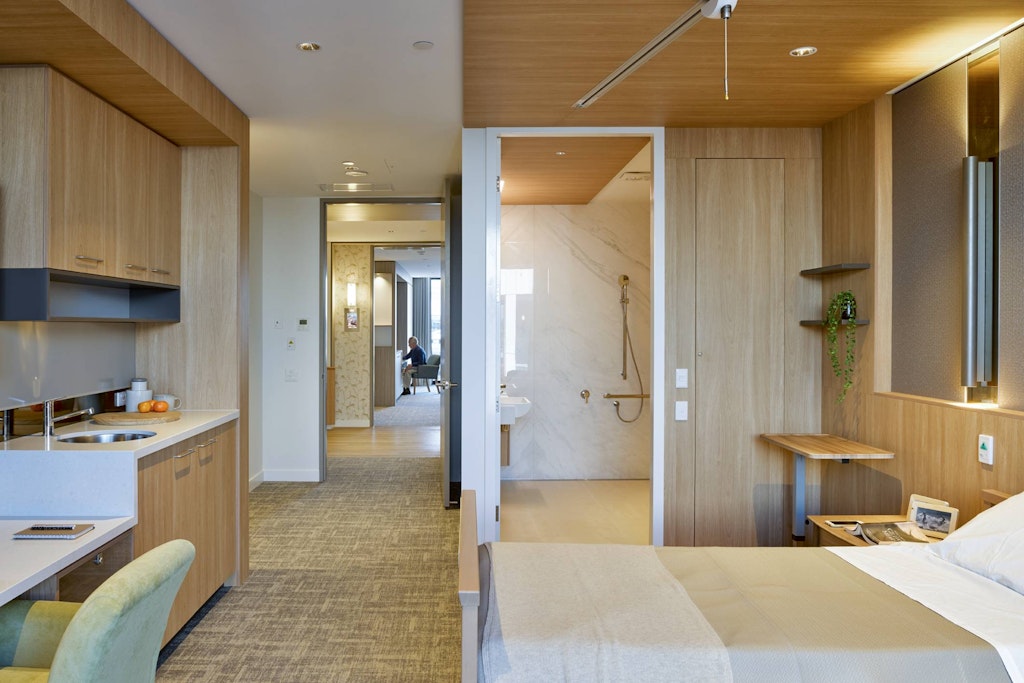Designing for joy – 5 ways to make aged care more dementia friendly
Last updated on 20 March 2025

An increased focus on specialised dementia care in residential aged care, community living and independent living, encompasses more than just how older people are cared for, it includes architectural design elements and the physical environment’s influence.
There are a number of dementia-friendly design elements at your disposal that will support engagement and resident wellbeing.
It could be as simple as aesthetic changes to create contrast and reduce confusion or the introduction of a new outdoor space designed for sensory stimulation.
Architecture and design firm, Deicke Richards, has experience designing residential aged care that better meet the needs of people with dementia.
Senior Interior Designer, Magda Myszkowski, spoke to Hello Leaders about some of the design elements they incorporate when designing places for older people with dementia.
1. Dementia-friendly outdoor spaces
By providing residents with a dementia-friendly garden – one that suits gardeners, readers, socialisers, etc – you can help promote social engagement and reduce agitation and apathy in people with dementia.
For some, it may be a safe space that reminds them of gardening at home, while others may just enjoy the time outdoors. The mental and physical rehabilitation possibilities through outdoor spaces could slow cognitive decline.
There are a number of elements to consider in a dementia-friendly garden. The layout, accessibility requirements, seating and shading and maintenance requirements are all important.
Then you have the plants themselves. They should be sensory-provoking; various colours of flowers and foliage, flowers and herbs with noticeable scents, and trees with leaves that rustle and crunch. You could even have a seasonal garden with fruit and vegetables for the residents to pick and eat.
Ms Myszkowski said connectivity to the natural environment plays a large role in providing comfort and serenity to aged care residents.
“A visual and physical connection to the landscape improves health and supports positive wellbeing,” said Ms Myszkowski.
“Places for ageing can provide a connection to nature by enabling unobstructed views of nature, the inclusion of green foliage walls, safely arranged potted plants, nature-inspired super graphics and murals, water features and fountains.
“Safe access to gardens that are shaded and have a clear and defined path arranged in a circuit encourages exercise and movement, prompting meaningful use and interaction through activities like gardening.”
2. Defined spaces
Ms Myszkowski said reducing confusion should be at the forefront of design when planning a facility. If a resident was to lose their bearings or forget which way to turn, it helps to be able to see a common area or familiar space to help them recentre themselves.
She explained if they have to walk past more than four rooms, the chances of confusion increase.
“Legibility is a key safety principle when designing environments for dementia as it allows residents to clearly understand where they are and where they want to go,” explained Ms Myszkowski.
“Confusion and agitation make anybody function more poorly, thus smaller more familiar environments will reduce stress and enable a resident to function at their best.
“Through planning, visual cues can be strengthened to assist with wayfinding, such as being able to see the bathroom from the bed.”
Alongside the layout, contrast supports the identification of spaces and usage. Easily defined items such as handrails, doors and toilet seats allow residents with dementia to spot them more easily and have a sense of familiarity.
Multipurpose spaces also benefit from design contrasts. For instance, large communal areas need to be versatile, as sometimes they can be overpowering, so distinction and separation help.
“We have achieved this by providing subtle division of spaces through decorative mobile partitioning screens and by varying ceiling heights and floor finish, timber vinyl to dining areas and inset ‘rug like’ carpet to indicate lounge spaces,” said Ms Myszkowski.
“While providing improved acoustics, a sense of privacy and retaining an openness, these settings can support both large group gatherings and intimate conversations providing a choice to be alone or with others, to see and be seen.”

3. Bright and even lighting
The lighting within your aged care home is crucial to promoting a dementia-friendly environment. For some people with dementia, the brain may interpret dark and light spots in very different ways.
Dark spots may cause distress as the brain can’t accurately process what is being seen. Therefore, you want to balance any contrast with even, consistent lighting.
“Appropriate lighting plays a significant role in safety, reducing the risk of fall accidents and spatial confusion,” said Ms Myszkowski.
“Naturally lit interiors with window coverings provide the resident with a choice to adjust natural lighting to their needs.
“The colour of the light is important too; artificial lighting which adjusts to circadian rhythm has benefits such as boosting concentration, promoting productivity and improving residents’ mood and behaviour.”
Cool lighting – which has more of a blue tone – is also often used in household kitchens as it promotes activity. Whereas, warm lighting – more of a yellow tone – is best for bedrooms where it can relax the mind and reduce stimulation at night.
Installing smart lighting around your aged care facility means you can program it to mimic natural light. For example, it would be cooler in the morning but warmer towards the end of the day.
4. Familiar, homelike settings
The personalisation of space is a great way to make a resident with dementia feel safe and comfortable. You want their own room to feel familiar and for common areas to express a sense of community and belonging.
One way to achieve a sense of familiarity is to add personalised touches to rooms. Past examples include ‘The Front Door Project’ where facilities individually painted resident doors to resemble their childhood homes, or used their favourite colours.
At Deicke Richards, there is a focus on removing any sense of “institution” living. Ms Myszkowski mentioned one facility where the design incorporated a domestic-style kitchen where food is warmed and served to residents, but the harsher elements of a commercial kitchen are hidden away.
Other design elements they’ve incorporated into homes include hoist tracks that visually recede into the ceiling bulkhead and corridor handrails integrated into the wall panelling.
Personalisation also helps, whether it’s the introduction of furniture or decorations from a resident’s own home or design elements that feel warm and nostalgic.
“The use of traditional finishes i.e. wallpaper with pattern and texture may be nostalgic for some residents, proving a sense of familiarity,” said Ms Myszkowski.
“Authentic finishes like natural timber and stone are comforting and warm, providing a sense of where one feels valued because the quality of the place tells them they’re worth something.”
She added that the use of bright and cheerful colours can also contribute to reducing anxiety and enhancing a sense of wellbeing among residents.

5. Enhance creative activities
Fostering creativity in residential aged care allows residents to express themselves and remain mentally or socially engaged. Creativity is arguably more important for residents with dementia.
There are several ways to enhance creative activities, such as a dedicated art gallery offering definition and direction. It’s an engaging space with a clear purpose and artwork can be visible all year round.
Defined creative spaces will attract people who gravitate towards those pursuits, build relationships, and feel included – something that is incredibly helpful for newer residents. The presence of an art gallery, games room or music studio could ignite newfound interest in residents.
Technology can also be used for a wide range of creative sessions. Whether it is installed in a large common area or perhaps a purpose-built room for a small group, interactive projectors feature a number of games and sensory experiences.
Specifically designed to be used by people with dementia, projectors are a mess-free way to encourage movement and active participation. This could be a simple way to utilise multipurpose rooms without overcrowding the space.
Designing for joy
Ultimately, the design of your building is going to influence how residents feel and act. Residents with dementia need to be supported in a purpose-built environment where they can thrive.
Ms Myszkowski summed it up best when she outlined her design goals.
“Our places for people living with dementia focus on supporting a quality of life as their cognitive capacity declines by helping to reduce key symptoms like agitation, confusion, aggression, anxiety and loneliness,” said Ms Myszkowski.
“We all want to live a life of joy, purpose, connection and belonging, that is our ultimate goal when designing for all.”
Have you adopted dementia-friendly design elements? Tell us in the comments below.